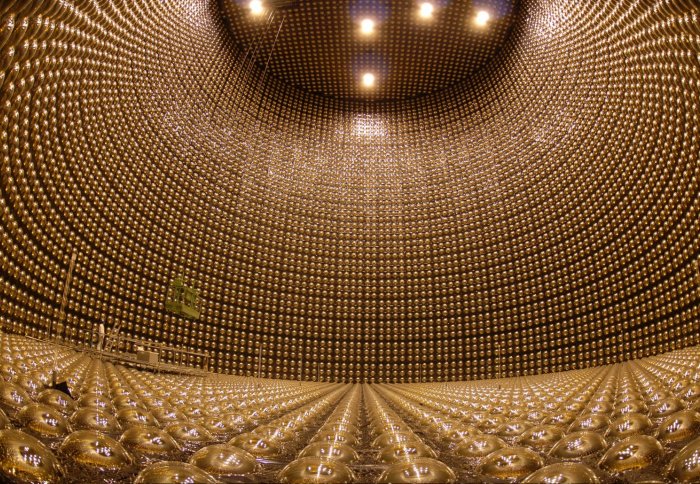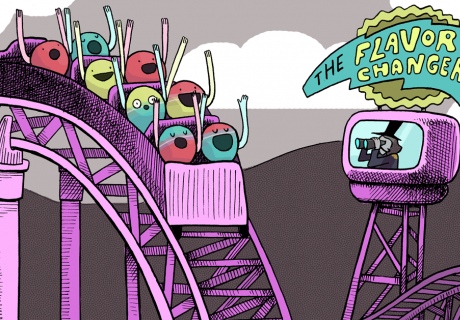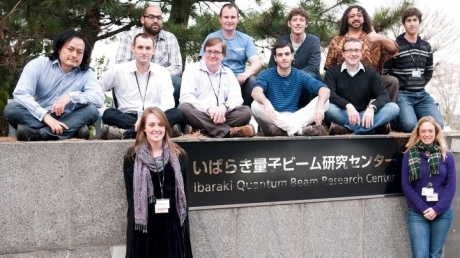Scientists closer to explaining why matter persists over antimatter

Inside the Super-Kamiokande neutrino detector
New results show a difference in the way neutrinos and antineutrinos behave, which could help explain why there is so much matter in the universe.
The results, announced today by the international team of scientists including large group from Imperial College London, suggest there could be a difference between the behaviour of matter and antimatter.
The T2K Collaboration of scientists studies the properties of neutrinos and their antimatter counterparts, antineutrinos. Neutrinos are fundamental particles that make up our universe and are among the least understood. Yet every second around 50 trillion neutrinos from the Sun pass through your body.
Understanding whether neutrinos and antineutrinos behave differently is important, because if all types of matter and antimatter behave the same way, they should have completely wiped each other out shortly after the Big Bang. If this were the case, our universe would not exist.
Neutrinos and antineutrinos can both change between three ‘flavours’ as they travel, named electron, muon and tau neutrinos. Changes between the three flavours are known as oscillations.

Neutrino oscillation. Image: Symmetry magazine
To explore these oscillations, the T2K experiment fires a beam of neutrinos or antineutrinos from the J-PARC laboratory on the eastern coast of Japan. When the beam reaches the Super-Kamiokande detector, 295km away in western Japan, scientists then look for a difference in the oscillations of neutrinos and antineutrinos.
The latest experimental results looked at oscillations that resulted in the appearance of electron neutrinos and antineutrinos. There was a higher-than-expected rate of appearance for electron neutrinos compared to appearances of electron antineutrinos.
Testing new fundamental physics
Dr Morgan Wascko, international co-spokesperson for the T2K experiment from the Department of Physics at Imperial College London, said: “The current T2K result shows a fascinating hint that there's an asymmetry between the behaviour of neutrinos and antineutrinos; in other words an asymmetry between the behaviour of matter and antimatter. We now need to collect more data to enhance the significance of our observed asymmetry.”
One of the great privileges of being one of the people who does this final step is getting to know the result a little bit earlier than everyone else.
– Dr Patrick Dunne
The T2K Collaboration is an international team of around 500 physicists from 63 institutes in 11 countries including the UK, Japan, the US, Canada, France, and Switzerland. A large team from the Department of Physics at Imperial, led by Dr Yoshi Uchida and Dr Wascko, was involved in producing the latest result, including students and postdocs.
Dr Patrick Dunne, one of the lead analysers of the result, said: “The role I and several others at Imperial play is doing the statistical analysis to bring all this work together into a final result. We spend months checking that we’ve accounted for everything about our detector and our model of how the neutrinos interact.
“After all this is complete, one of the great privileges of being one of the people who does this final step is getting to know the result a little bit earlier than everyone else, which is really exciting.
“Hopefully these indications tell us that the current setup, and the experiments that we’re planning to follow it, will be able to perform precise measurements of these matter-antimatter differences. Compatibility with these measurements will be a very important test for new fundamental theories of physics to pass.”
From super to hyper
Although this work is promising, there are still systematic uncertainties, so the T2K team is designing an upgrade to the detector to enhance its sensitivities.
If you’d asked me in 2010 when we would be seeing the current result, I would have guessed sometime in the mid-2020s.
– Dr Phillip Litchfield
Dr Phillip Litchfield, who led Imperial’s review of the analysis, said: “The future experiment Imperial is most involved in is Hyper-Kamiokande, the upgrade to the Super-Kamiokande detector.
“This will achieve much more precise (and therefore also more definitive) results simply by virtue of being bigger and observing hundreds of times more neutrinos than we have collected to date. In this respect it’s rather like getting a better picture of nature by having a better camera.
“But another possibility we are actively involved in is to place a second detector module much further away on the same beamline, in South Korea rather than Japan. This in effect allows us to observe the same phenomena from a different angle.”

Members of Imperial's T2K team at J-PARC
Although the team might have to wait for upgrades and new experiments to confirm their result, Dr Litchfield notes that the science is moving forward much faster than anticipated. He said: “It is very exciting that we are able to produce these results so quickly.
“T2K has been in some sense lucky in that when we discovered electron neutrino appearance in 2013, the observed effect was much larger than expected when we designed the experiment. If you’d asked me in 2010 when we would be seeing the current result, I would have guessed sometime in the mid-2020s.
“The terrific speed at which we are finding these results is a challenge in itself – we have to look at all of our models and analysis techniques and ensure that they are detailed enough and robust enough to make this more complicated measurement, not the simpler one we imagined we might still be working towards in 2017.”
Article supporters
Article text (excluding photos or graphics) © Imperial College London.
Photos and graphics subject to third party copyright used with permission or © Imperial College London.
Reporter
Hayley Dunning
Communications Division